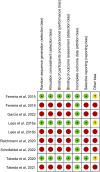Adverse event profiles of adjuvant treatment with opicapone in Parkinson's disease: A systematic review and meta-analysis
- PMID: 36506576
- PMCID: PMC9729693
- DOI: 10.3389/fphar.2022.1042992
Adverse event profiles of adjuvant treatment with opicapone in Parkinson's disease: A systematic review and meta-analysis
Abstract
Background: Opicapone, a novel third-generation catechol-O-methyltransferase inhibitor, has demonstrated efficacy in Parkinson's Disease (PD) patients with end-of-dose motor fluctuations. Objective: This study aimed to compare the short-term (<6 months) and long-term (≥6 months) tolerability of opicapone adjuvant treatment in PD patients. Method: Electronic databases including PubMed, Embase, Web of Science and Cochrane library were searched for randomized controlled trials (RCTs) and observational studies. The end points included any treatment-related adverse events (TEAEs), serious TEAEs (SAEs) and treatment discontinuation. A random-effects model was used to generate overall incidences of TEAE. Results: Three RCTs, three RCT extension studies and three open-label studies involving 2177 PD patients were evaluated. In the short-term studies, there were reports of TEAEs with an incidence of ≥5% in individuals treated with opicapone 50 mg, including dyskinesia (14.1%), elevated blood creatine phosphokinase levels (8.0%) and urinary tract infection (6.0%). Any TEAEs, SAEs and treatment discontinuation all occurred at rates of 62.9%, 4.8% and 9.3%, respectively. TEAEs with opicapone 50 mg that were reported by more than 5% of patients in long-term studies included dyskinesia (16.1%), dry mouth (12.1%), medication effect decreased (12.1%), PD exacerbated (7.8%), blood creatine phosphokinase level raised (7.4%), nausea (6.1%) and insomnia (5.1%). The incidence of any TEAEs, SAEs and treatment discontinuation were, correspondingly, 73.2%, 8.7% and 8.4%. Conclusion: These studies demonstrated that opicapone was generally well-tolerated and had a low risk of adverse events, suggesting that it could be a valuable therapeutic choice for people with PD.
Keywords: Parkinson’s disease; adjunctive treatment; adverse events; meta-analysis; opicapone.
Copyright © 2022 Xie, Qi, Wang, He, Wang, Zhang, Yu, Deng, Liang and Lü.
Conflict of interest statement
The authors declare that the research was conducted in the absence of any commercial or financial relationships that could be construed as a potential conflict of interest.
Figures




Similar articles
-
Effectiveness and safety of opicapone in Parkinson's disease patients with motor fluctuations: the OPTIPARK open-label study.Transl Neurodegener. 2020 Mar 4;9(1):9. doi: 10.1186/s40035-020-00187-1. Transl Neurodegener. 2020. PMID: 32345378 Free PMC article. Clinical Trial.
-
Safety Profile of Opicapone in the Management of Parkinson's Disease.J Parkinsons Dis. 2019;9(4):733-740. doi: 10.3233/JPD-191593. J Parkinsons Dis. 2019. PMID: 31498127 Clinical Trial.
-
Efficacy and Safety of Opicapone for Motor Fluctuations as an Adjuvant to Levodopa Therapy in Patients with Parkinson's Disease: A Systematic Review and Meta-Analysis.J Parkinsons Dis. 2022;12(3):773-783. doi: 10.3233/JPD-213057. J Parkinsons Dis. 2022. PMID: 35180134 Free PMC article.
-
The safety/tolerability of opicapone when used early in Parkinson's disease patients with levodopa-induced motor fluctuations: A post-hoc analysis of BIPARK-I and II.Front Neurol. 2022 Aug 23;13:994114. doi: 10.3389/fneur.2022.994114. eCollection 2022. Front Neurol. 2022. PMID: 36081875 Free PMC article.
-
Opicapone: A third generation COMT inhibitor.Clin Park Relat Disord. 2020 Dec 7;4:100083. doi: 10.1016/j.prdoa.2020.100083. eCollection 2021. Clin Park Relat Disord. 2020. PMID: 34316661 Free PMC article. Review.
Cited by
-
Disease Stage and Motor Fluctuation Duration Predict Drug Tolerability: A Real-Life, Prospective Italian Multicenter Study on the Use of Opicapone in Parkinson's Disease.Drugs Real World Outcomes. 2024 Sep;11(3):361-368. doi: 10.1007/s40801-024-00442-1. Epub 2024 Jul 2. Drugs Real World Outcomes. 2024. PMID: 38954191 Free PMC article.
References
-
- Bonifácio M. J., Sutcliffe J. S., Torrão L., Wright L. C., Soares-da-Silva P. (2014). Brain and peripheral pharmacokinetics of levodopa in the cynomolgus monkey following administration of opicapone, a third generation nitrocatechol COMT inhibitor. Neuropharmacology 77, 334–341. 10.1016/j.neuropharm.2013.10.014 - DOI - PubMed
-
- Chong D. J., Suchowersky O., Szumlanski C., Weinshilboum R. M., Brant R., Campbell N. R. (2000). The relationship between COMT genotype and the clinical effectiveness of tolcapone, a COMT inhibitor, in patients with Parkinson's disease. Clin. Neuropharmacol. 23, 143–148. 10.1097/00002826-200005000-00003 - DOI - PubMed
Publication types
LinkOut - more resources
Full Text Sources

